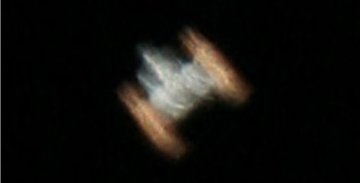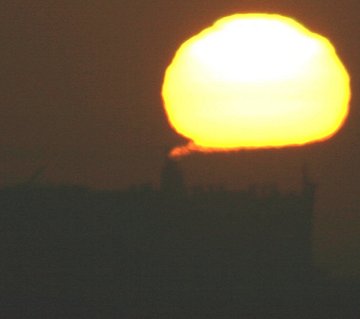 Where's Saturn? Is that a UFO--or the ISS? What's the name of that star? Get the answers from mySKY--a fun new astronomy helper from Meade. Where's Saturn? Is that a UFO--or the ISS? What's the name of that star? Get the answers from mySKY--a fun new astronomy helper from Meade. SOLAR ACTIVITY: The face of the sun may be blank, but the edge is seething with activity. This prominence was photographed yesterday by Eric Roel of Valle de Bravo, México and it remains visible today. If you have a solar telescope, take a look. WINGED SPACESHIP: Space shuttle Atlantis has landed, but the International Space Station (ISS) is still in orbit and flying over many US cities after dark this weekend. If you glimpse the ISS in the eyepiece of a backyard telescope, this is what you might see: 
Photo details: Canon Digital Rebel 350D, Takahashi Mewlon 250 Telescope.
"I took this hand-guided photo with a digital camera and a 10-inch telescope," says photographer John Cordiale of Queensbury, New York. "It was quite a sight." The copper-colored wings are solar arrays. Two weeks ago, the one on the right didn't exist. It was unfurled for the first time on June 12th by astronauts from Atlantis. Measuring 240 feet from tip to tip, the arrays provide power and a pleasing symmetry to the ISS. Would you like a call when the ISS is about to fly over your home town? Sign up for SpaceWeather PHONE. BALL OF FIRE: On June 14th photographer Mila Zinkova stood on a beach near her home in San Francisco and looked out across the waves. In the distance, a ball of fire emerged from the smokestack of a passing ship: 
Really, it was the sun. Green flash and mirage specialist Andrew Young explains: "Thermal turbulence in the ship's exhaust plume is scattering light from the sun into the plume, with a deflection of several minutes of arc." Later, as the sun set behind the plume, the distortion grew producing a figure that "looked like a solar prominence--right here on Earth," says Minkova. It all goes to show, you never know what you might see when you look at the sunset. | 
